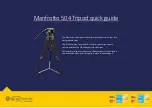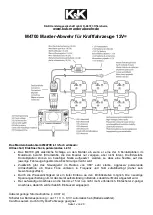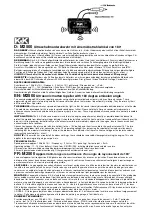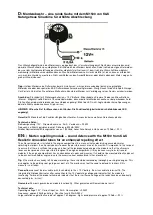
NOTES for the SDU5000
(Rev 1.3)
1.
First ensure that the receiver is switched On and connected to the SDU5000. The SDU ROM will
permit operation with the AOR AR3000A, ICOM IC-R7000, IC-R7100, IC-R9000 and as a band scope
with other receivers with a 10.7 MHz I.F. output such as the AOR AR3000 (a small modification is
required to the AOR receivers in order to provide compatibility).
If using an ICOM receiver, the CT17 optional interface will be required. The ICOM receiver must be
configured for remote control, refer to the ICOM operating manual. The following setup is required:
Baud rate
9600 bps
Frequency data
5 Byte
Transceive
ON
Address default
IC-R7000
08H
IC-R7100
34H
IC-R9000
2AH
Example setup for the ICOM IC-R7100 receiver
Step 1.
For transceive ON
On the ICOM receiver, press and hold both "3" and "ENT" keys and switch the power switch ON.
Then switch the receiver OFF.
Step 2.
For baud rate of 9600
On the ICOM receiver, press and hold both the "5" and "ENT" keys and switch the power switch ON.
Then switch the receiver OFF.
The receiver must be configured and switched On before the SDU5000 in order to guarantee a valid
connection via the RS232.
Note: The output level of the ICOM receiver(s) is about 10 - 15dB below that of the AOR receiver(s).
2.
Should the connection be lost, use “CONF” to confirm that the correct receiver had been selected.
3.
If a connection cannot be established, switch Off the SDU5000, unplug the 12V DC feed and leave
the unit for 10 seconds. Reconnect and try again.
4.
It is possible to get false indications below 0 MHz !! (minus figures will appear in front of the
frequency readout).
5.
A small false signal may appear on some bands to the right (or left) of the centre in a constant
position (455kHz), this is normal and due to an internal 455 kHz I.F. of the receiver.
6.
When tuning in channelised bands ensure the correct STEP size is selected (i.e. 9kHz for medium
wave).
7.
Depending upon the step size, resolution and span a frequency (say 198 kHz) way appear up to 5
or 6 kHz off frequency. Reset the centre frequency and the error will be reduced. This effect is
MOST noticeable when using the "marker" and is explained here.
Each division of the graticule has 16 steps so dividing the entire screen into 160 steps. To work out
the frequency shift for each movement of the marker take the chosen bandwidth (SPAN), divide
this kHz bandwidth by 10 then by 16... the answer will be in kHz.
i.e. for a bandwidth of 10 MHz, each shift will be 10000 / 10 / 16 = 62.5 kHz
P.T.O.
Summary of Contents for SDU-5000
Page 1: ......
Page 2: ......
Page 3: ......
Page 4: ......
Page 5: ......
Page 6: ......
Page 7: ......
Page 8: ......
Page 9: ......
Page 10: ......
Page 11: ......
Page 12: ......
Page 13: ......
Page 14: ......
Page 15: ......
Page 16: ......
Page 17: ......
Page 18: ......
Page 19: ......
Page 20: ......
Page 21: ......
Page 22: ......
Page 23: ......
Page 24: ......
Page 25: ......
Page 26: ......
Page 27: ......


































